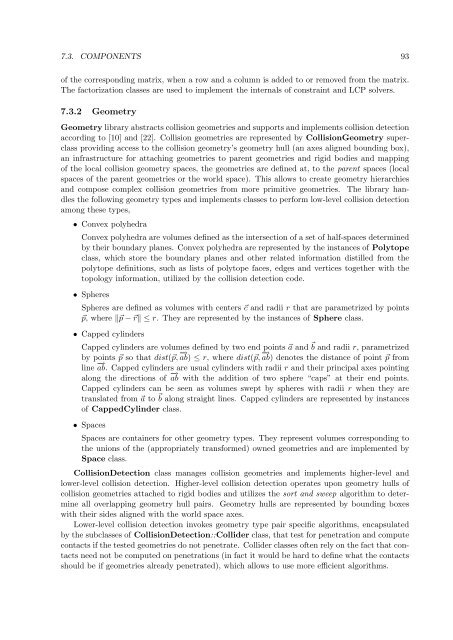thesis - Computer Graphics Group - Charles University - Univerzita ...
thesis - Computer Graphics Group - Charles University - Univerzita ...
thesis - Computer Graphics Group - Charles University - Univerzita ...
You also want an ePaper? Increase the reach of your titles
YUMPU automatically turns print PDFs into web optimized ePapers that Google loves.
7.3. COMPONENTS 93<br />
of the corresponding matrix, when a row and a column is added to or removed from the matrix.<br />
The factorization classes are used to implement the internals of constraint and LCP solvers.<br />
7.3.2 Geometry<br />
Geometry library abstracts collision geometries and supports and implements collision detection<br />
according to [10] and [22]. Collision geometries are represented by CollisionGeometry superclass<br />
providing access to the collision geometry’s geometry hull (an axes aligned bounding box),<br />
an infrastructure for attaching geometries to parent geometries and rigid bodies and mapping<br />
of the local collision geometry spaces, the geometries are defined at, to the parent spaces (local<br />
spaces of the parent geometries or the world space). This allows to create geometry hierarchies<br />
and compose complex collision geometries from more primitive geometries. The library handles<br />
the following geometry types and implements classes to perform low-level collision detection<br />
among these types,<br />
• Convex polyhedra<br />
Convex polyhedra are volumes defined as the intersection of a set of half-spaces determined<br />
by their boundary planes. Convex polyhedra are represented by the instances of Polytope<br />
class, which store the boundary planes and other related information distilled from the<br />
polytope definitions, such as lists of polytope faces, edges and vertices together with the<br />
topology information, utilized by the collision detection code.<br />
• Spheres<br />
Spheres are defined as volumes with centers c and radii r that are parametrized by points<br />
p, where p − r ≤ r. They are represented by the instances of Sphere class.<br />
• Capped cylinders<br />
Capped cylinders are volumes defined by two end points a and b and radii r, parametrized<br />
by points p so that dist(p, −→ ab) ≤ r, where dist(p, −→ ab) denotes the distance of point p from<br />
line −→ ab. Capped cylinders are usual cylinders with radii r and their principal axes pointing<br />
along the directions of −→ ab with the addition of two sphere “caps” at their end points.<br />
Capped cylinders can be seen as volumes swept by spheres with radii r when they are<br />
translated from a to b along straight lines. Capped cylinders are represented by instances<br />
of CappedCylinder class.<br />
• Spaces<br />
Spaces are containers for other geometry types. They represent volumes corresponding to<br />
the unions of the (appropriately transformed) owned geometries and are implemented by<br />
Space class.<br />
CollisionDetection class manages collision geometries and implements higher-level and<br />
lower-level collision detection. Higher-level collision detection operates upon geometry hulls of<br />
collision geometries attached to rigid bodies and utilizes the sort and sweep algorithm to determine<br />
all overlapping geometry hull pairs. Geometry hulls are represented by bounding boxes<br />
with their sides aligned with the world space axes.<br />
Lower-level collision detection invokes geometry type pair specific algorithms, encapsulated<br />
by the subclasses of CollisionDetection::Collider class, that test for penetration and compute<br />
contacts if the tested geometries do not penetrate. Collider classes often rely on the fact that contacts<br />
need not be computed on penetrations (in fact it would be hard to define what the contacts<br />
should be if geometries already penetrated), which allows to use more efficient algorithms.
















